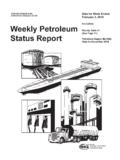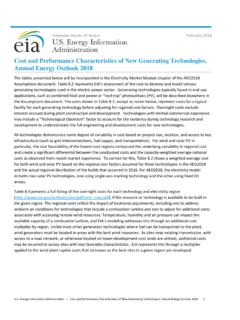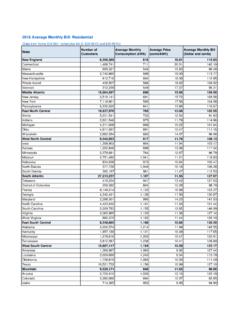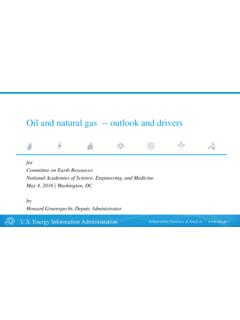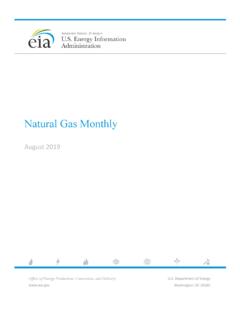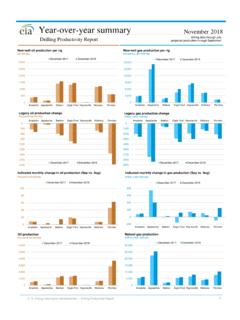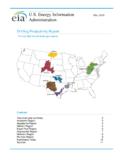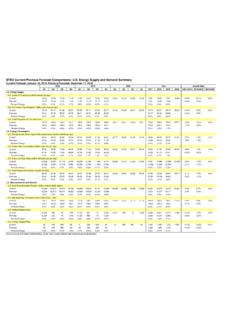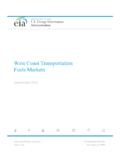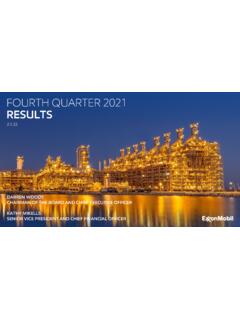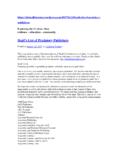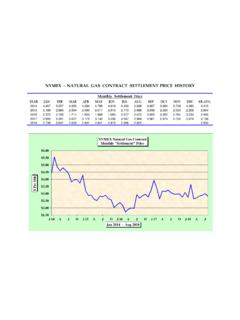Transcription of Winter Fuels Outlook
1 Energy Information Administration | Winter Fuels Outlook October 2021 1 October 2021 Winter Fuels Outlook As we head into the Winter of 2021 22, retail prices for energy are at or near multiyear highs in the United States. The high prices follow changes to energy supply and demand patterns in response to the COVID-19 pandemic. We expect that households across the United States will spend more on energy this Winter compared with the past several winters because of these higher energy prices and because we assume a slightly colder Winter than last year in much of the United States. Even when we vary weather expectations, we expect the increase in energy prices as the United States returns to economic growth to mean higher residential energy bills this Winter : We expect that the nearly half of households that heat primarily with natural gas will spend 30% more than they spent last Winter on average 50% more if the Winter is 10% colder-than-average and 22% more if the Winter is 10% warmer-than-average.
2 We expect the 41% of households that heat primarily with electricity will spend 6% more 15% more in a colder Winter and 4% more in a warmer Winter . The 5% of households that heat primarily with propane will spend 54% more 94% more in a colder Winter and 29% more in a warmer Winter . The 4% of households that heat primarily with heating oil will spend 43% more 59% more in a colder Winter and 30% more in a warmer Winter . Forecast expenditures can also vary significantly across regions and Fuels for this Winter (see Winter Fuels Outlook table). Background. Our expectation of a colder Winter is based on forecasts from the National Oceanic and Atmospheric Administration (NOAA). NOAA s expectation is a key input to our energy consumption forecast and contributes to our expectation of increases in Winter energy consumption. For this Outlook , we define the Winter heating season as October through March.
3 The average household Winter energy expenditures discussed in this supplement are broad measures for comparing recent winters and reflect energy expenditures for all uses, not just heating. Fuel expenditures for individual households depend on the size and energy efficiency of individual homes and their heating equipment, along with thermostat settings and weather conditions. Each fuel also has its own market structure, physical infrastructure, regulations, and limitations that can affect the connection between wholesale and retail market events. Energy Information Administration | Winter Fuels Outlook October 2021 2 We use our Residential Energy Consumption Survey (RECS) as a baseline to estimate average energy consumption during the Winter in each region. To develop our forecast household expenditures for natural gas, heating oil, electricity, and propane in this report, we group households by their primary space heating fuel.
4 We forecast total Winter expenditures for all uses for each primary heating fuel, not just the portion attributable to heating. For example, the expenditures included for households that heat primarily with electricity in this report would also include electricity used for appliances and lighting. Because electricity has the widest range of uses among the Fuels , electricity consumption tends to be less sensitive to changes in temperatures than other Fuels . On average across the United States, we expect prices for all Fuels to be higher than in recent winters. Rising wholesale commodity prices for natural gas, crude oil, and petroleum products are being passed through to retail prices. Although we attribute price increases over the past year to several factors, the main reason wholesale prices of natural gas, crude oil, and petroleum products have risen is that fuel demand has increased from recent lows faster than production.
5 This dynamic has led to falling inventories, as in the case of crude oil and several petroleum products, and inventories increasing by less during the summer than historical averages, as in the case of natural gas and propane. For petroleum products, commodity price changes are passed to consumers quickly. On October 1, benchmark Brent crude oil spot prices were $79 per barrel (b), which was up 51% from last Winter s average, and we expect average retail prices this Winter for propane to be about 49% higher and heating oil to be 33% higher than last Winter s average. Commodity price changes affect residential prices for natural gas and, particularly, electricity prices over relatively longer periods because these costs are incorporated into regulated rates. Even with a lag, increases in spot commodity prices over the past year are pushing up retail prices this Winter . henry Hub natural gas spot prices were $ per million British thermal units (MMBtu) on October 1, which is up 84% from last Winter s average.
6 This price increase contributes to our forecast that residential natural gas prices this Winter will be 27% higher than last Winter and that residential electricity prices will be 5% hgher than last Winter . Based on NOAA s most recent Winter forecast, we assume temperatures for the Winter of 2021 22 will be slightly colder than last Winter s for most of the country and more similar to the average Winter of the previous 10 years. We use heating degree days (HDDs) as a measure of how cold temperatures are compared with a base temperature more HDDs indicate colder temperatures. On average, we expect 3% more population-weighted HDDs for the Winter of 2021 22 across the United States than last Winter and 1% more than the previous 10- Winter average. Regionally, changes from last Winter are fairly consistent. We forecast that the Northeast, Midwest, and West will all have 3% to 4% more HDDs this Winter than Winter 2020-21, and that HDDs in the South will be about the same as last Winter .
7 Because weather is a significant source of uncertainty in these forecasts, the Winter Fuels Outlook includes scenarios where, measured in HDDs, all regions are 10% colder or 10% warmer Energy Information Administration | Winter Fuels Outlook October 2021 3 than the baseline forecast. As last year demonstrated, even in close-to-average Winter , severe energy market disruptions can occur. Earlier this year, a cold snap in February affected much of the country, particularly Texas, and caused disruptions to energy supplies that continue to affect energy markets. Although these weather events are inherently unexpected, the prevailing high prices and low inventory levels across a range of Fuels heading into this Winter mean that even short spells of severe weather have the potential to affect energy markets. Cold weather can affect household heating expenditures in two ways. First, it raises the amount of energy required to keep a house at a specific temperature.
8 Second, because it raises demand and could cause supply disruptions, cold weather can cause energy prices to rise, a development that can be more acute in a time of low fuel inventories. Although this effect exists across all Fuels , the effects are likely to be most acute for propane, for which wholesale-to-retail price pass-through occurs quickly and cold weather can significantly affect market dynamics and prices. For example, in the Midwest, the market where cold weather has caused propane supply issues in past winters, we expect that in a 10% colder-than-forecast scenario, propane retail prices would be about 12% higher and households would consume 12% more propane, leading to expenditures that are 26% higher than in our base case. For natural gas, however, the immediate effects of a cold Winter come more from the consumption side. In a 10% colder-than-forecast scenario, we forecast natural gas retail prices would be 2% higher, with 13% more consumption, leading to expenditures that are 15% higher than in our base case.
9 Natural Gas. Nearly half of all households heat primarily with natural gas. We expect households that use natural gas as their primary space heating fuel will spend $746 this Winter , 30% more than they spent last Winter . This increase in natural gas expenditures comes from both higher expected prices and higher expected consumption. We forecast that an average of billion cubic feet per day (Bcf/d) will be consumed by residences this Winter . For households that use natural gas as their primary space heating fuel, we expect average household consumption for the Winter to total 58 thousand cubic feet (Mcf), up 2% from last Winter . We forecast a 3% increase in average natural gas consumption per household in the Northeast, Midwest, and West. We expect residential natural gas consumption in the South to be about the same as last year. We forecast that the residential natural gas price for homes in the United States that heat primarily with natural gas will average $ , up from an average of $ last Winter .
10 We forecast higher residential prices because of higher commodity prices for natural gas in much of 2021 compared with 2020, when we had historically low natural gas prices. Changes in natural gas spot prices generally pass through to residential customers relatively slowly. Some state utility commissions set the rates that utilities can charge for natural gas deliveries a year or more in advance of billing to reflect the cost of wholesale natural gas that utilities purchased over many months. In addition, residential prices include charges to cover Energy Information Administration | Winter Fuels Outlook October 2021 4 utility operating costs and the cost to transport and distribute natural gas, which are not directly linked to wholesale commodity natural gas prices. However, given the increases in natural gas commodity prices over the past year, we expect consumers to experience larger increases in retail prices than they have in previous winters.
